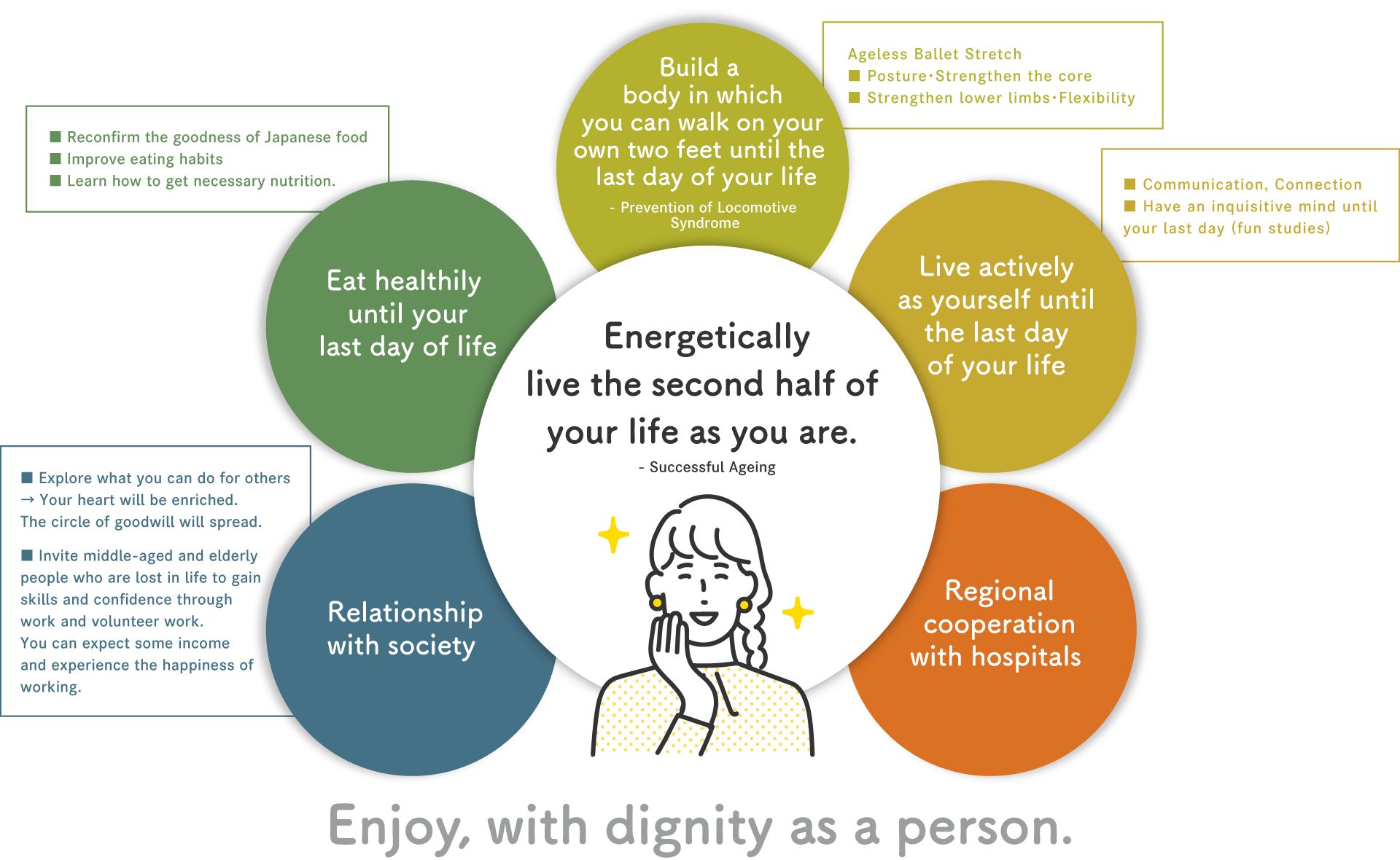What kind of environment do you surround yourself with? Live your own way through the last days of your life…
Instead of living aimlessly, we think it is important to have a goal about how you would like to live as you age, to gather information and build your body (with exercise and food), so that you can live your life with independence and mobility.
For example, it would be wonderful to be able to speak about your dreams even in your 80s! In order to live your life energetically, your environment is also important. It is important to have social connections and to cooperate with community-based healthcare in case of an emergency.

※1) Locomotive Syndrome
Proposed by the Japanese Orthopedic Association in 2007, Locomotive Syndrome is, “a condition in which locomotive function is impaired due to a disorder of the locomotive organs.” Another term for this is Musculoskeletal Syndrome. The musculoskeletal system is the tissue and organs involved in moving the body, and is composed of bones, muscles, joints, ligaments, tendons, nerves, and so on.
The main causes of needing long-term care in 2013 were categorized as, “hyposthenia due to old age,” “fractures/falls,” and “joint diseases.” These are categorized as musculoskeletal disorders, and account for 36.1% of those needing support or long-term care—the most common cause. Locomotive Syndrome cases in Support 1 account for 52.1% of the total, and in Support 2, 49.6%, or about half. This indicates that the degree of independence in daily life tends to decrease due to locomotive or musculoskeletal disorders (From the website of the Japan Foundation for Aging and Health
https://www.tyojyu.or.jp/en/index.html ).
※2 Aging Successfully
“Aging Successfully” in American gerontology is translated as “happy aging”, but it does not mean that one is simply happy by chance. It also implies an active aging process, of “Aging Successfully”. In order to age successfully, it is important to “avoid illness and disease,” “maintain high physical and mental functionality,” and to “keep in touch with those around you, as well as to act proactively.”

※Gerontological studies supported by the MacArthur Foundation have been empirically
Japan uses a Support/Nursing scale that ranges from 1-5, 1 needing the least help, and 2 needing more support in order to categorize patients needing supplemental care. After support 1 and 2, there is Nursing 1-5, the higher the number the more help they need.
conducted in the United States to analyze healthy, active, and productive older people to determine the factors for successful aging.
The Japan Ageless Ballet Stretch Association wants to realize a society where everyone can grow happy and live their lives their own way, no matter how old they are. We develop and provide the content necessary for that purpose and train instructors.
Our Vision for the Future:
For the Middle-aged and the Elderly-
Middle-aged and elderly people (from their 40s until end of life) are enthusiastic about what they are interested in without being bound by stereotypes about how they should behave.
People of all ages can work happily or volunteer according to their level of physical fitness. By working even a little, you can connect with society= we think it is important to be aware that you are a needed.
Ageless Ballet Stretch spreads for the purpose of physical and mental health, as well as enjoyment.
Cooking and dietary guidance using Japanese traditions such as Jiuqu (malted rice) and kelp will have become common place, and many people are free of obesity and illness.
Teams of advisors will have spawned new initiatives and the participants of the initiatives are pleased with the results.
People Involved and Supporting Companies:
Through our activities, we are creating new communication with advisors, groups, and individuals, and by doing so, are getting to know and inspiring them.
Regardless of gender, nationality, or race, we recognize the differences in our values and cooperate with each other to achieve our major goals.
We demonstrate our strengths and cooperate with each other to make the event a success with passion and determination.
The people involved are active and happy.
Support companies have expanded by word of mouth, and more and more people are comfortable buying their products.
Participants (the Middle Aged and the Elderly), Staff, and Companies can all play a leading role:
A lively world is growing!
The Difference Between Healthy Life Expectancy and Average Life Expectancy is 12.35 years for Women.
What does this mean?
According to Cabinet Office Data, the difference between average life expectancy and a healthy life expectancy was 8.84 years for men, and 12.35 years for women in Fiscal Year 2016.
In women, this is a difference of more than 12 years.
Healthy life expectancy is the period of life expectancy in which you can live a healthy and active life. Advocated by WHO (World Health Organization), it is the average life expectancy minus a long-term care period due to hyposthenia, illness, dementia, etc.
In other words, it is the duration of your ability to live an independent life.

https://www8.cao.go.jp/kourei/whitepaper/w-2019/html/zenbun/s1_2_2.html
2 健康・福祉|令和元年版高齢社会白書(全体版) - 内閣府 (cao.go.jp)

Why are ballet stretches effective against locomotive syndrome?
~ From the American Orthopedic Association~
https://www.prnewswire.com/news-releases/want-to-improve-joint-mobility-flexibility-and-strength-consider-ballet-300352799.html